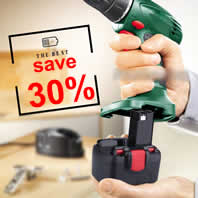Cordless Drill Batteries
- DEWALT Power Tool Batteries
- BOSCH Cordless Drill Battery
- MAKITA Power Tool Batteries
- HITACHI Tool Batteries
- PANASONIC Tool Battery
- RYOBI Power Tool Battery
- BLACK & DECKER Battery
- AEG Power Tool Battery
- MILWAUKEE Drill Batteries
- FIRESTORM Tool Battery
- METABO Cordless Drill Battery
- CRAFTSMAN Tool Batteries
- PASLODE Power Tool Battery
- NATIONAL Drill Batteries

Hot Sales Drill Batteries
UK Tool Battery Store > How to Choose a Cordless Drill
How to Choose a Cordless Drill
With advances in technology in recent years, cordless drills are a popular and viable choice for nearly all hand held drilling tasks on almost any woodworking project. Cordless drills come in various sizes and with a number of different features.
What features should you look for when buying a cordless drill?
Begin With the Battery:
When looking for a cordless drill to meet your woodworking needs, the first thing to consider is the battery. Cordless drills are presently available in voltages from 9.6 volts all the way up to 24 volts. The advantage of a more powerful battery translates to additional torque for driving long screws into stronger hardwoods. It also likely means longer battery life per charge.
However, these stronger tool batteries also mean a considerably heavier drill. A 24-volt cordless drill is much heavier than a 12-volt cordless drill, and considerably heavier than a corded power drill.
Mandatory Features
Any cordless drill that you should consider for your woodworking projects should have a number of basic features. These include a reversible motor that will allow you to back out any screws that you drill in, a dual-speed motor (with a high and low switch) and an adjustable clutch, that, when adjusted properly, will help keep you from driving screws too deeply into your wood stock.
Additional Features to Consider
Many cordless drills use a 3/8" chuck to hold your bits. However, some larger models have a 1/2" chuck that will allow one to use drill bits of up to 1/2" in diameter. These 1/2" models often include a "hammer drill" feature which has little practical application for woodworking, but is great for drilling holes in masonry.
Many recent cordless drill models employ a "smart charger" that will help extend battery life by optimizing the way the batteries are charged. On these chargers, when the battery is approaching a "full" charge, the charger switches to a trickle-charge mode until the battery is maxed.
Many models will also include two cordless drill batteries with the drill and charger, which, while it is not a requirement, is certainly a good idea. With two batteries, you can be using one and charging the other at the same time.
How to Choose
Ironically, a great many of the cordless drills available on the market have all of the features we've already discussed. What, then, should you look for to differentiate between these models?
In my mind, there are two major factors to consider when all else is equal. First, when you look at the batteries, look beyond the voltage. For instance, all 12-volt batteries are not the same. When comparing batteries of the same voltage, the battery with a higher mAh rating (which stands for milliamp-hours) will hold a charge for a longer period of time.
The other factor to consider comes into play when you pick up the drill with the battery installed. Hold the drill in a number of positions, including over your head, as if you were drilling screws into your ceiling. Ask yourself questions like, "How does this drill feel?" "Is it balanced?" "How long could I use this drill holding it over my head?"
If the drill is simply too heavy to comfortably use over your head for at least 30 seconds at a time, then you likely need to look at a drill with a lower battery voltage (and hence, a smaller size). The drill should be strong, but comfortable to use.
The bottom line is, if you don't find your drill comfortable, then you won't enjoy using it. Find one that feels good in your hand and you'll be more likely to put it to good use on all of your woodworking projects.

